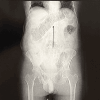Anorectal Melanoma: A Rare Cause of Large Bowel Obstruction
- PMID: 38618462
- PMCID: PMC11015112
- DOI: 10.7759/cureus.56128
Anorectal Melanoma: A Rare Cause of Large Bowel Obstruction
Abstract
Anorectal melanoma is a rare and aggressive malignancy with a challenging diagnosis and management. We present the case of a 69-year-old male with a history of chronic constipation and recent weight loss, who presented with symptoms suggestive of anorectal pathology. Despite initial diagnostic challenges, including an unsuccessful colonoscopy due to inadequate bowel preparation, the subsequent radiographic evaluation revealed a large bowel obstruction secondary to a protruding anorectal mass. Abdominal X-ray demonstrated significant colonic dilation while contrast-enhanced CT scan revealed a large hypodense mass protruding from the anal canal. Surgical intervention led to the excision of the mass, and histopathological examination confirmed malignant melanoma. Immunohistochemistry markers, including HMB 45, Melan A, and S100, supported the diagnosis. This case underscores the importance of considering anorectal melanoma in patients presenting with atypical anorectal symptoms, despite its rarity. Early recognition and intervention, supported by appropriate imaging modalities, are critical for optimizing patient outcomes in such cases.
Keywords: abdominal perineal resection; anorectal melanoma; large bowel obstruction; malignant melanoma; melanoma.
Copyright © 2024, Dnyanmote et al.
Conflict of interest statement
The authors have declared that no competing interests exist.
Figures







Similar articles
-
Amelanotic Malignant Melanoma With Atypical Divergent Neuroendocrine Differentiation: A Report of an Unusual and Rare Case of Anorectal Bleeding.Cureus. 2024 Aug 14;16(8):e66905. doi: 10.7759/cureus.66905. eCollection 2024 Aug. Cureus. 2024. PMID: 39280438 Free PMC article.
-
A Rare Case of Primary Anorectal Melanoma and a Review of the Current Landscape of Therapy.J Community Hosp Intern Med Perspect. 2020 Aug 2;10(4):371-376. doi: 10.1080/20009666.2020.1787809. J Community Hosp Intern Med Perspect. 2020. PMID: 32850102 Free PMC article.
-
Anorectal malignant amelanotic melanoma: Report of a rare aggressive primary tumor.J Cancer Res Ther. 2022 Jan-Mar;18(1):249-252. doi: 10.4103/jcrt.JCRT_461_20. J Cancer Res Ther. 2022. PMID: 35381792
-
Anorectal Mucosal Melanoma: A Case Report and Literature Review.Am J Case Rep. 2021 Oct 26;22:e933032. doi: 10.12659/AJCR.933032. Am J Case Rep. 2021. PMID: 34699518 Free PMC article. Review.
-
Anorectal mucosal melanoma.Oncotarget. 2018 Jan 2;9(9):8785-8800. doi: 10.18632/oncotarget.23835. eCollection 2018 Feb 2. Oncotarget. 2018. PMID: 29492238 Free PMC article. Review.
Cited by
-
Early diagnosis and delayed treatment of anorectal melanoma in a 19-year-old female: A case report.Int J Surg Case Rep. 2025 Jul;132:111518. doi: 10.1016/j.ijscr.2025.111518. Epub 2025 Jun 14. Int J Surg Case Rep. 2025. PMID: 40517678 Free PMC article.
-
Anorectal melanoma: systematic review of the current literature of an aggressive type of melanoma.Melanoma Res. 2024 Dec 1;34(6):487-496. doi: 10.1097/CMR.0000000000001003. Epub 2024 Oct 4. Melanoma Res. 2024. PMID: 39361336 Free PMC article.
References
-
- The National Cancer Data Base report on cutaneous and noncutaneous melanoma: a summary of 84,836 cases from the past decade. The American College of Surgeons Commission on Cancer and the American Cancer Society. Chang AE, Karnell LH, Menck HR. https://pubmed.ncbi.nlm.nih.gov/9781962/ Cancer. 1998;83:1664–1678. - PubMed
-
- Anorectal melanoma--an incurable disease? Thibault C, Sagar P, Nivatvongs S, Ilstrup DM, Wolff BG. Dis Colon Rectum. 1997;40:661–668. - PubMed
-
- Black is the new black: prolapsing primary anorectal melanoma. Jensen C, Kin C. Dig Dis Sci. 2017;62:2991–2993. - PubMed
Publication types
LinkOut - more resources
Full Text Sources
